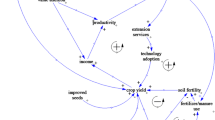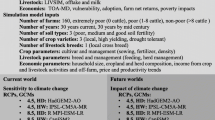Abstract
Dairy farmers face increasing pressure to decrease environmental impact while remaining economically viable. Adaptation of farm management practices in response to seasonal climate forecasts may be one means of achieving these objectives. This paper describes the interactive and iterative process by which farmers, researchers, extension agents, regulatory agencies, and other stakeholders collaborated to create, calibrate, and validate the Dynamic North Florida Dairy Farm model (DyNoFlo), a whole-farm decision support system to decrease nitrogen leaching while maintaining profitability under variable climate conditions. Participatory modeling may enhance the creation of adoptable and adaptable user-friendly models that include environmental, economic and biophysical components. By providing farmers, policy makers, and other stakeholders with a more holistic view of current practices, common ground among them was more easily identified and collaboration was fostered. Farmer values included willingness to be good environmental stewards when they are profitable. The participatory research and development process enhanced understanding of and potential adaptation to seasonal climate variability conditioned to the El Niño Southern Oscillation (ENSO) phases in light of increasing environmental regulations and economic challenges. Adoption of the collaboratively-developed DyNoFlo is expected to be higher than usual because stakeholders feel greater ownership of the final product.
Similar content being viewed by others
References
Alvira D, Cabrera VE, Galindo S, et al (2003) Nutrient management in the Suwannee River Basin: perceptions of stakeholders. University of Florida, Food and Resource Economics Department, Staff Paper Series, SP 04-2. Gainesville
Archer D, Eklund J, Walsh M, et al (2002) WEEDEM: A user-friendly software package for predicting annual ryegrass and wild radish emergence. In: Spafford JH, Dodd J, Moore JH. (eds) WEEDS: “threats now & forever?” p. 252–253. In Proc. 13th Australian Weeds Conf., Perth, WA, September 8–13, 2002. Department of Primary Industries, Water and Environment, Government of Tasmania. Hobart, Tasmania, Australia
Bernard HR (1995) Research Methods in Anthropology: Qualitative and quantitative approaches. Sage. Newbury Park, CA
Cabrera VE, Hildebrand PE (2004) Economic and ecologic assessment of groundwater nitrogen pollution from North Florida dairy farm systems: an interdisciplinary approach. Sixth IFSA European Symposium of the Farming Systems and Rural Systems Research and Extension. Vila Real, Portugal. April 2004. Pp. 857–870. Available at: http://home.utad.pt/∼des/ifsa/ifsa_6th_eu_proceed.pdf
Cabrera VE, Breuer NE, Hildebrand PE (2005) The dynamic North-Florida dairy farm model: a user-friendly computerized tool for increasing profits while minimizing environmental impacts. Comput Electron Agric 49:286–308
Cabrera VE, Breuer NE, Hildebrand PE (2006a) North Florida stakeholder perception toward the use of climate forecast technology, nutrient pollution, and environmental regulations. Clim Change 78:479–491
Cabrera VE, Hildebrand PE, Jones JW, Letson D, de Vries A (2006b) An integrated North Florida dairy farm model to reduce environmental impacts under seasonal climate variability. Agric Ecosyst Environ 113:82–97
Chambers R (1994) The origins and practice of participatory rural appraisal. World Dev 22:953–959
Department of Environmental Protection (DEP) (2001) Florida water conservation initiative. Agricultural working group. A report of the Florida Department of Environmental Protection. Orlando, FL
Florida Department of Environmental Protection (FLDEP) (2001) Basin status report: Suwannee. Division of Water Resource Management. Bureau of Water Management, Tallahassee, FL. Available at: ftp://ftp.dep.state.fl.us/pub/water/basin411/suwannee/ status/SUWANNEE.pdf
Geurtz JLA, Joldersma F (2001) Methodology for participatory policy analysis. Eur J Oper res 128:300–310
Geurtz JLA, Vennix AJ (1989) Verkenningen in Beleidsanalyse: Theorie en Praktijk van Modelbouw en Simulatie. Kercke-bosch, Zeist
Hammer GL, Nicholls N, Mitchell C (2000) Applications of seasonal climate forecasting in agricultural and natural ecosystems: The australian experience. In: Hammer GL, Nicholls N, Mitchell C (eds) Applications of seasonal climate forecasting in agricultural and natural ecosystems –the Australian Experience. Kluwer Academic, The Netherlands
Hansen JW (2002a) Applying seasonal climate prediction to agricultural production. Agr Syst 74:305–307
Hansen JW (2002b) Realizing the potential benefits of climate prediction to agriculture: issues, approaches, challenges. Agr Syst 74:309–330
Hansen JW, Jones JW, Kiker CF, Hodges AH (1999) El Niño-Southern Oscillation impacts on winter vegetable production in Florida. J Climate 12:92–102
Hildebrand PE (1981) Combining disciplines in rapid appraisal: the sondeo approach. Agric Adm 8(6):423–432
Jagtap SS, Jones JW, Hildebrand PE, Letson D, O’Brien JJ, Podestá G, Zierden D, Zazueta P (2002) Responding to stakeholders’ demands for climate information: from research to applications in Florida. Agr Syst 74:415–430
Jones JW, Hoogenboom G, Porter CH et al (2003) The DSSAT cropping system model. Eur J Agron 18:235–265
Jones CS, Shriver JF, O, Brien JJ (1999) The effects of El Niño on rainfall and fire in Florida. Fla Geogr 30:55–69
Jones JW, Thornton PK, Hansen JW (1997) Opportunities for systems approaches at the farm scale. In: Teng PS et al (ed) Applications for systems approaches at the farm and regional levels. Syst. Approaches for Sustainable Agric. Dev. 5. Kluwer Acad. Publ, Dordrecht, The Netherlands, pp 1–18
Keating BA, McCown RL (2001) Advances in farming systems analyses and intervention. Agr Syst 70:555–579
Lightfoot C (2003) Demand-driven extension: some challenges for policy makers and managers. On CTA Observatory ICTs – transforming agricultural extension. Wageningen, Netherlands. September, 2003. Available: http://www.cta.int/observatory2003/keynote_papers/Challenges_in-demand-driven_extension.pdf
Meinke HWE, Stone RC (2005) Seasonal and inter-annual climate forecasting: the new tool for increasing preparedness to climate variability and change in agricultural planning and operations. Clim Change 70:221–253
Meinke HWE, Baethgen PS, Carberry M et al (2001) Increasing profits and reducing risks in crop production using participative systems simulation approaches. Agr Syst 70:493–513
Natural Resource Conservation Service (NRCS) (2001) Water budget and nutrient balance worksheet, WATNUTFL Vers. 2.0. Part 650, Engineering Field Handbook. 210-VI-EFH. Gainesville, FL
Nelson RA, Holzworth DP, Hammer GL, Haymand PT (2002) Infusing the use of seasonal climate forecasting into crop management practice in North East Australia using discussion support software. Agr Syst 74:393–414
Nicholls N (2000) Opportunities to improve the use of seasonal climate forecasts. In: Hammer GL, Nicholls N, Mitchell C (eds) Applications of seasonal climate forecasting in agricultural and natural ecosystems. Kluwer, Dordrecht, pp 309–327
Norman D, Collison M (1985) Farming systems research in theory and practice. In: Remenyi JV (ed) Agricultural systems research for developing countries. Australian centre for international agricultural research proceedings No. 11, ACIAR. Canberra, Australia, pp 16–30
O’Brien JJ, Zierden DF, Legler D, et al (1999) El Niño, La Niña and Florida’s climate: effects on agriculture and forestry. The Florida Consortium: The Florida State Univ., The Univ. of Florida, University of Miami. Tallahassee, FL
Onema JG, Koskamp L, Galama PJ (2001) Guiding commercial pilot farms to bridge the gap between experimental and commercial dairy farms: the project ‘cows and opportunities. Neth J Agr Sci 49:277–296
Paine M, Weatherly J, Crawford A, Champion A (2002) Farmlets as learning platforms: a national approach to farming systems research, development and extension in the Australian dairy sector. In Proc. Fifth IFSA European Symposium, Florence, Italy 8–11 April 2002. International Farming Systems Association, European Group, Dip. di Economia Agraria e delle Risorce Territoriali, Facolta di Agraria, Universita degli Studi di Firenze, Florence, Italy, pp 729–738
Palmer T (2005) Preface. Tellus 57:217
Phillips JG, Unganai L, Makaudze E (2001) Current and potential use of seasonal forecasts for resource poor farmers in Zimbabwe. In: Rosenzweig C (ed) Impacts of El Nino and climate variability in agriculture. Spec Publ 63. American Society of Agronomy, Madison, WI, pp 87–100
Ribaudo M, Gollehon N, Aillery M, et al (2003) Manure management for water quality costs to animal feeding operations of applying manure nutrients to land. Agricultural Economic Report 824. Resource Economics Division. Economic Research Service. U.S. Department of Agriculture. Washington, DC
Robertson MJ, Carberry PS, Lucy M (2000) Evaluation of a new cropping option using a participatory approach with on-farm monitoring and simulation: a case study of spring sown mungbeans. Aust J Agr Res 51:1–12
Rogers EM (2003) Diffusion of innovations. Fifth Edition. New York, NY: Free Press
Roncoli C (2006) Ethnographic and participatory approaches to research on farmers’response to climate predictions. Clim Res 33:81–89
Rosenhead J (ed) (1989) In: Rational analysis for a problematic world: problem structuring methods for complexity, uncertainty and conflict. Wiley, Chichester, UK
Shaner WW, Philipp PF, Schmehl WR (1982) Farming systems research and development: guidelines for developing countries. Westview Press, Boulder
Sivakumar MVK (2006) Climate prediction agriculture: current status and future challenges. Clim Res 33:3–17
Stern P, Easterling WE (eds) (1999) In: Making climate forecasts matter. National research council/national academy of sciences. National Academy Press, Washington, DC
Stewart DW, Shamdasani PN (1990) Focus groups: theory and practice. Sage, London
Stoorvogel JJ, Bouma J, Orlich RA (2004) Participatory research for systems analysis: prototyping for a Costa Rican banana plantation. Agron J 96:323–336
Suwannee River Partnership. 2004. Suwannee River Partnership Background. Suwannee River Water Management District. Accessed May, 2004, http://www.srwmd.state.fl.us/ resources/22x11.pdf
Van Horn HH, Newton GL, Nordstedt RA et al (1998) Dairy manure management: strategies for recycling nutrients to recover fertilizer value and avoid environmental pollution. Florida Coop. Ext. Serv. Circ. 1016. Univ. Florida, Gainesville, FL
Verburgh LD (1994) Participative policy modeling, applied at the health care insurance industry. Ph.D. thesis. Benda. Nijmegen, the Netherlands
Ziervogel G, Downing TE (2004) Stakeholder networks: improving seasonal climate forecasts. Clim Change 65:73–101
Author information
Authors and Affiliations
Corresponding author
Rights and permissions
About this article
Cite this article
Cabrera, V.E., Breuer, N.E. & Hildebrand, P.E. Participatory modeling in dairy farm systems: a method for building consensual environmental sustainability using seasonal climate forecasts. Climatic Change 89, 395–409 (2008). https://doi.org/10.1007/s10584-007-9371-z
Received:
Accepted:
Published:
Issue Date:
DOI: https://doi.org/10.1007/s10584-007-9371-z




